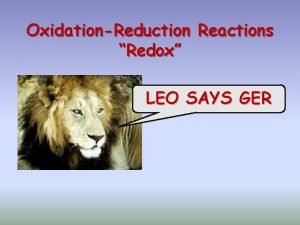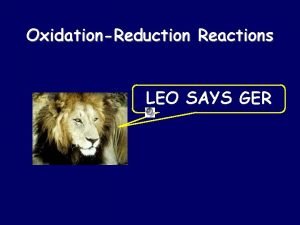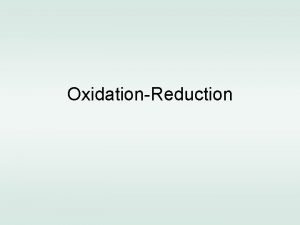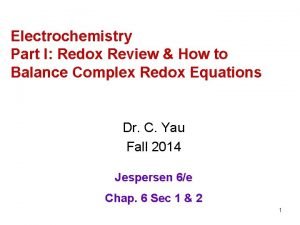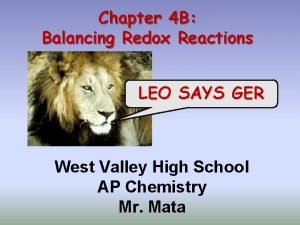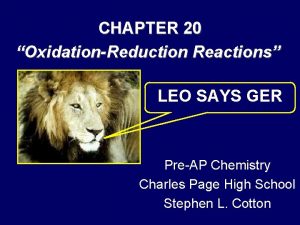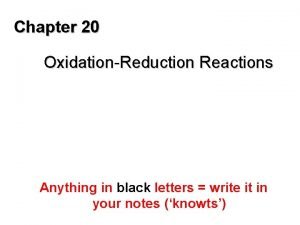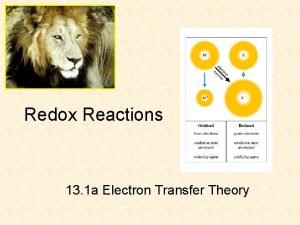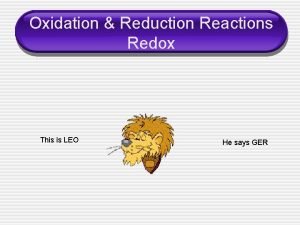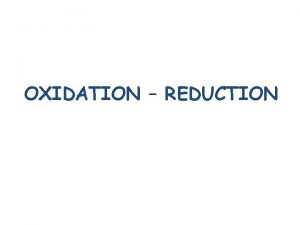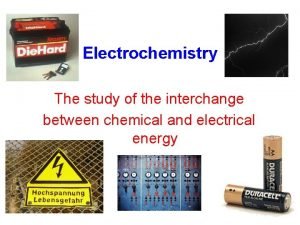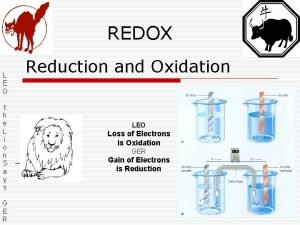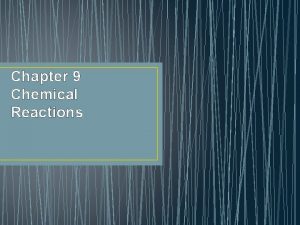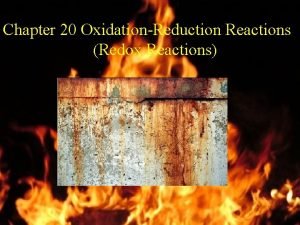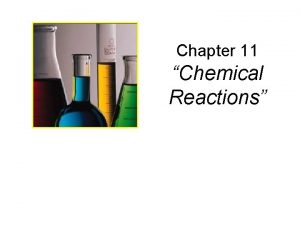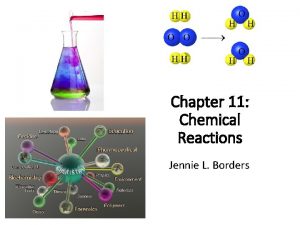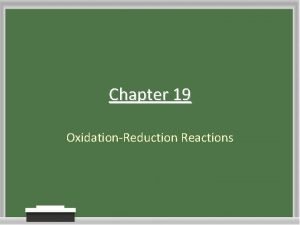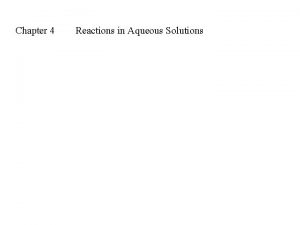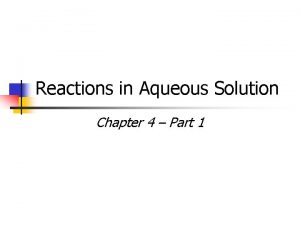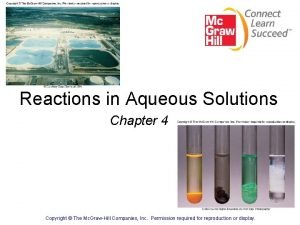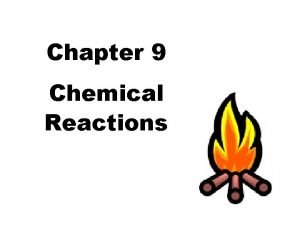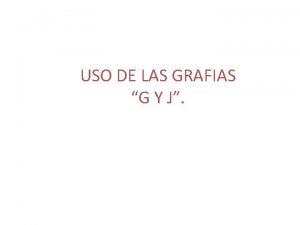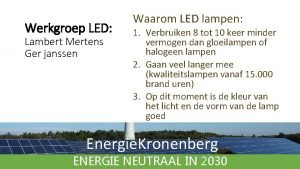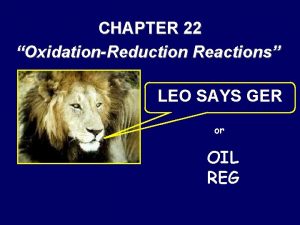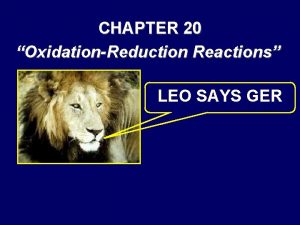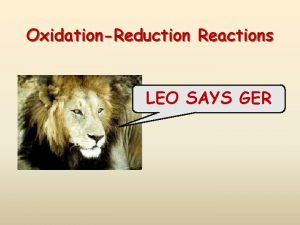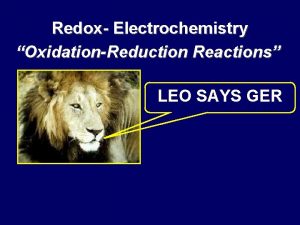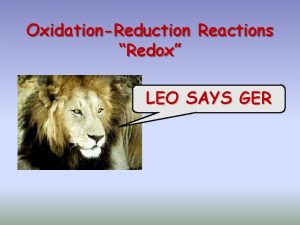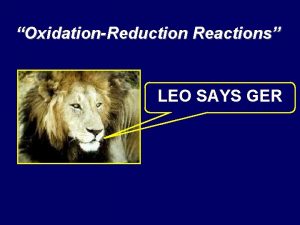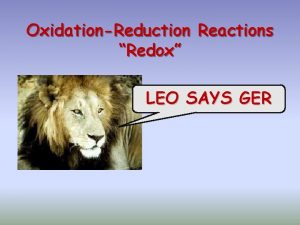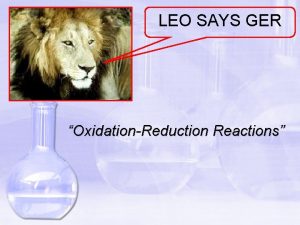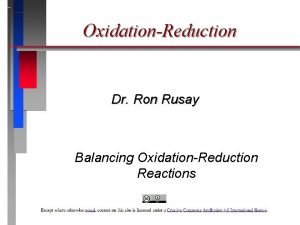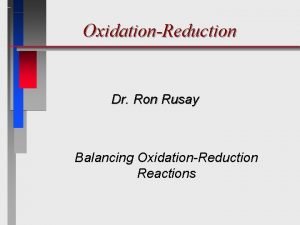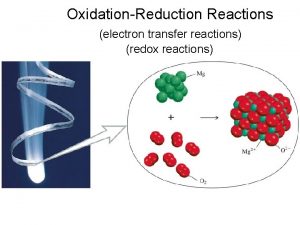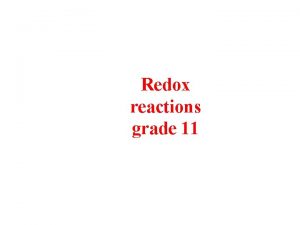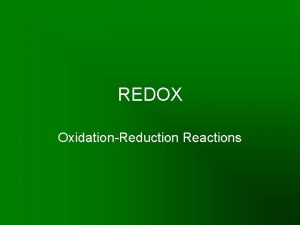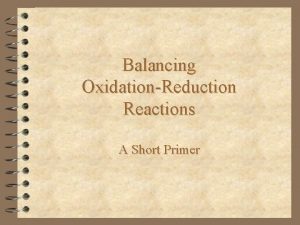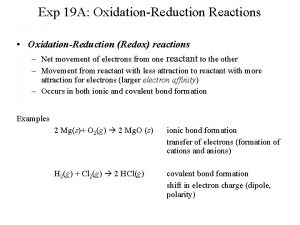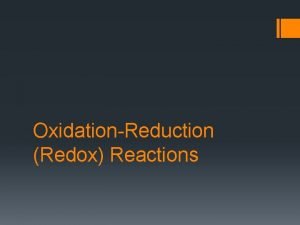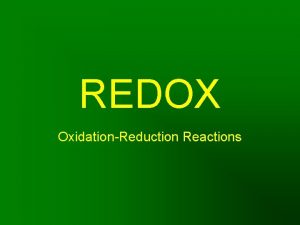CHAPTER 20 OxidationReduction Reactions LEO SAYS GER 20














































- Slides: 46

CHAPTER 20 Oxidation-Reduction Reactions LEO SAYS GER

20. 2

Section 20. 2 - Oxidation Numbers Objectives • Determine the oxidation number of an atom of any element in a pure substance. • Define oxidation and reduction in terms of a change in oxidation number, and identify atoms being oxidized or reduced in redox reactions.

Remember Oxidation Numbers

Oxidation Numbers What is an oxidation number: • An oxidation number is a positive or negative number assigned to an atom to keep track of electron transfers & electron sharing

Rules for Assigning Oxidation Numbers 1. The oxidation number of any uncombined element is zero. 2. The oxidation number of a monatomic ion equals its charge. 0 0 2 Na + Cl 2 +1 -1 2 Na. Cl

Rules for Assigning Oxidation Numbers 3. The oxidation number of O in compounds is -2, Exceptions: • in hydrogen peroxide: H 2 O 2 where it is -1, • in compounds with the more electronegative fluorine F 2 O +1 -2 H 2 O 2(+1) + 1(-2) = 0 +1 -1 H 2 O 2 2(+2) + 2(-2) = 0 -1 +2 F 2 O 2(-1) + 1(+2) = 0

Rules for Assigning Oxidation Numbers 4. The oxidation number of H in compounds is +1, Exception: in metal hydrides it is -1. +1 -2 H 2 O +1 -1 Na. H Warning! • Don't get too bogged down in these exceptions. In most of the cases you will come across, they don't apply!

Rules for Assigning Oxidation Numbers 5. For any neutral compound, the sum of the oxidation numbers of the atoms in the compound must equal 0. +1 -2 H 2 O 2(+1) + (-2) = 0 H O +2 -2 +1 Ca(OH)2 (+2) + 2(-2) + 2(+1) = 0 Ca O H

Rules for Assigning Oxidation Numbers 6. For a polyatomic ion, the sum of the oxidation numbers in the formula is equal to the ionic charge of the ion ? -2 NO 3 - SO 42 - X + 3(-2) = -1 N O X + 4(-2) = -2 S O THUS X = +5 THUS X = +6

20. 1

Section 20. 1 – The Meaning of Oxidation and Reduction • Objectives: – Define oxidation and reduction in terms of loss or gain of oxygen and the loss or gain of electrons – State the characteristics of a redox reaction – Describe what happens to iron when it corrodes

Oxidation and Reduction • We already learned why salt is spread on roads during winter months – Lowers the freezing point of water preventing the buildup of slippery ice • But…what about the affect of the salt that clings to the metallic parts of cars? – RUST • The corrosion of metal is one example of an oxidation-reduction reaction

Other Examples of Oxidation-Reduction Reactions • When methane burns in air, it oxidizes and forms oxides of carbon and hydrogen – One oxide of carbon is carbon dioxide • Elemental iron slowly oxidizes into compounds such as iron (III) oxide, or rust • Hydrogen peroxide also releases oxygen when it decomposes – when you pour it on an open cut • Bleaching stains in fabrics is an oxidation-reduction reaction

Oxidation and Reduction • What is an oxidation-reduction reaction? – Classic Definition: A reaction where oxygen is transferred from one substance to another. • In an oxidation-reduction reaction: – The substance gaining oxygen is oxidized – The substance losing oxygen is reduced. • Oxidation & reduction always occur simultaneously • An abbreviation for oxidation-reduction reactions is redox reactions

Redox Reactions • Modern concepts of redox reactions include reactions that do not even involve oxygen • Redox reactions are currently understood to involve the shift of electrons between reactants • Oxidation » Complete or partial loss of electrons, or » gain of oxygen • Reduction » Complete or partial gain of electrons, or » loss of oxygen

Why call it Oxidation? • With the exception of fluorine, oxygen is the most electronegative element – When oxygen bonds with atoms of different elements, the electrons from the other atom shift toward oxygen – When a substance gains electrons, it acting like oxygen

Oxidation and Reduction Until now our view of a reaction: Mg + S Mg. S Reaction viewed as Redox: Mg + S→ Mg 2+ + S 2 - • The magnesium atom changes to a more stable magnesium ion by losing 2 electrons, and is thus oxidized • The sulfur atom is changed to a more stable sulfide ion by gaining 2 electrons, and is thus reduced.

Oxidation and Reduction Mg + S Mg. S • The over all process is represented as the two component processes below: Mg S + 2 e- Mg 2+ + 2 e. S 2 - Oxidation – loss of electrons Reduction – gain of electrons

Example 2: Oxidation and Reduction Each sodium atom loses one electron – oxidation Each chlorine atom gains one electron – reduction

LEO says GER Lose Electrons = Oxidation Sodium is oxidized Gain Electrons = Reduction Chlorine is reduced

Remember • Oxidation - reduction reactions involve a transfer of electrons. • LEO - GER – Lose Electrons Oxidation – Gain Electrons Reduction

Practice Problem Determine what is oxidized and what is reduced in each reaction. Na is oxidized 2 Na +SSis (Na 1+ S 2 -) Na 2 S reduced Al is oxidized (Al 3+ O 2 -) 4 Al + 3 O 2 O is reduced 2 Al 2 O 3

Practice Problem Identify these processes as either oxidation or reduction. S 2 - S + 2 e- Zn 2+ + 2 e- Oxidation – is loss Zn Reduction – is gain

Redox in Covalent Compounds • It is easy to see the loss and gain of electrons in ionic compounds, but what about covalent compounds? (complete electron transfer does not occur) • Remember when we did bonding, we looked at Electronegativity = strong pull on the electron. • If the electrons are shared between two atoms, the atom with the higher Electronegativity has the electron most of the time. • So the oxidation number will show the electron belonging to the atom with the higher Electronegativity • (In reality the e- is not completely transferred, but it helps us keep track of where the e- is)

Redox in Covalent Compounds It is easy to see the loss and gain of electrons in ionic compounds, but what about covalent compounds? (complete electron transfer does not occur) • Consider: 2 H 2 + O 2 2 H 2 O • Oxygen is highly electronegative • In H there is a shift of bonding electrons away from H • • loss Hydrogen is oxidized In O there is a shift of electrons toward O • Oxygen is reduced gain

Oxidation and Reduction • In some reactions involving covalent reactants and products, the partial electron shifts are less obvious – A few general guidelines: • • • Gain of oxygen – oxidation Loss of oxygen – reduction Loss of hydrogen by a covalent compound – oxidation Gain of hydrogen by a covalent compound – reduction Increase in oxidation number – oxidation Decrease in oxidation number – reduction

Terminology for Redox Oxidation Reduction – Loss of electrons – Increase in oxidation number - Gain of electrons - Decrease in oxidation number – Increase in oxygen - Decrease in oxygen Oxidizing Agent – Electron acceptor – Species that is reduced Reducing Agent - Electron donor - Species that is oxidized

Trends in Oxidation and Reduction Active metals: Lose electrons easily Are easily oxidized Are strong reducing agents Active nonmetals: Gain electrons easily Are easily reduced Are strong oxidizing agents

Oxidation – Number Changes in Chemical Reactions • An increase in oxidation number = oxidation • A decrease in oxidation number = reduction – Determining all of the oxidations in a chemical equation allows us to determine the oxidizing agent and reducing agent (which species is oxidized and which species is reduced) • Determine the oxidation numbers in the following chemical equation. 2 Ag. NO 3 + Cu +1 +5 -2 0 Copper is oxidized Silver is reduced Cu(NO 3)2 + 2 Ag +2 +5 -2 0

20. 3

Section 20. 3 – Balancing Redox Equations Objectives: • Describe how oxidation numbers are used to identify redox reactions. • Balance a redox equation using the oxidationnumber-change method. • Balance a redox equation by breaking the equation into oxidation and reduction halfreactions, and then balance using the half-reaction method.

Identifying Redox Equations In general, all chemical reactions can be assigned to one of two classes: 1) oxidation-reduction, in which electrons are transferred: • Single-replacement, combination, decomposition, and combustion 2) All other reactions… • No electron transfer • Double-replacement and acid-base reactions

Identifying Redox Equations • In an electrical storm, oxygen and nitrogen react to form nitrogen monoxide: N 2(g) + O 2(g) → 2 NO(g) YES! • Is this a redox reaction? • If the oxidation number of an element in a reacting species changes, then that element has undergone either oxidation or reduction; therefore, the reaction as a whole must be a redox reaction.

Balancing Redox Equations • It is essential to write a correctly balanced equation that represents what happens in a chemical reaction • Many redox reactions are too complex to be balanced by trial and error • Fortunately, there are two systematic methods based on the fact that the total electrons gained in reduction equals the total lost in oxidation • The methods: • Using oxidation-number changes • Use half-reactions

Using Oxidation-Number Changes • Type of “chemical bookkeeping” to keep track of electron transfers – Balance a redox equation by comparing the increases and decreases in oxidation number • Start with the skeleton equation Fe 2 O 3 + CO Fe + CO 2 (unbalanced) 1. Assign oxidation numbers to all the atoms in the equation Fe 2 O 3 + CO Fe + CO 2 +3 -2 +2 -2 0 +4 -2

Using Oxidation-Number Changes 2. Identify which atoms are oxidized and which are reduced • Iron decreases in oxidation number from +3 to 0, a change of -3. Iron is reduced • Carbon increases in oxidation number from +2 to +4, a change of +2. Carbon is oxidized 3. Use brackets to connect the atoms that undergo oxidation and another to connect those that undergo reduction. Write the oxidation number change on the line. +2 oxidation Fe 2 O 3 + CO -3 reduction Fe + CO 2 As the equation is written, the number of electrons transferred in oxidation, does not equal the number of electrons transferred in reduction

Using Oxidation-Number Changes 4. Make the total increase in oxidation number equal to the total decrease in oxidation number by using appropriate coefficients 3 X (+2) = + 6 Fe 2 O 3 + CO Fe + CO 2 2 X (-3) = - 6 Using the numbers you multiplied the oxidation number changes by, add appropriate coefficients to the equation Fe 2 O 3 + 3 CO 2 Fe + 3 CO 2 5. Finally, make sure that the equation is balanced for both atoms and charges. If necessary, finish balancing the equation by inspection

Using Oxidation-Number Changes • Balance this redox reaction by using the oxidationnumber-change method K 2 Cr 2 O 7 + H 2 O + S KOH + Cr 2 O 3 + SO 2 3 X + 4 oxidation = + 12 +6 0 +3 K 2 Cr 2 O 7 + H 2 O + S 4 X - 3 reduction 2 K 2 Cr 2 O 7 + 2 H 2 O + 3 S +4 KOH + Cr 2 O 3 + SO 2 = - 12 4 KOH + 2 Cr 2 O 3 + 3 SO 2

Using Half-Reactions • A half-reaction is an equation showing just the oxidation or just the reduction that takes place • They are then balanced separately, and finally combined 1. Write unbalanced equation in ionic form 2. Write separate half-reaction equations for oxidation and reduction 3. Balance the atoms in the half-reaction 4. Add enough electrons to one side of each half-reaction to balance the charges 5. Multiply each half-reaction by a number to make the electrons equal in both 6. Add the balanced half-reactions to show an overall equation 7. Add the spectator ions and balance the equation Rules shown on page 651 – bottom

You can’t have one… without the other! • Reduction (gaining electrons) can’t happen without an oxidation to provide the electrons. • You can’t have 2 oxidations or 2 reductions in the same equation. Reduction has to occur at the cost of oxidation GER!

Using Half-Reactions Consider the reduction of Ag+ ions with copper metal. Cu + Ag+ --give--> Cu 2+ + Ag

Using Half-Reactions Step 1: Step 2: Step 3: Divide the reaction into halfreactions, one for oxidation and the other for reduction. Ox Cu ---> Cu 2+ Red Ag+ ---> Ag Balance each element for mass. Already done in this case. Balance each half-reaction for charge by adding electrons. Ox Cu ---> Cu 2+ + 2 e. Red Ag+ + e- ---> Ag

Using Half-Reactions Step 4: Multiply each half-reaction by a factor so that the reducing agent supplies as many electrons as the oxidizing agent requires. Reducing agent Oxidizing agent Step 5: Cu ---> Cu 2+ + 2 e 2 Ag+ + 2 e- ---> 2 Ag Add half-reactions to give the overall equation. Cu + 2 Ag+ ---> Cu 2+ + 2 Ag The equation is now balanced for both mass & charge

Practice Problem Balance the following equation using the half reaction method Zn + HNO 3 Zn(NO 3)3 + NO 2 + H 2 O Step 1: Identify the oxidized and reduced species by assigning oxidation numbers 0 +1 +5 Zn + H N O 3 -2 +2 +5 -2 +4 Zn (N O 3)3 + N O -2 +1 2 + H 2 O -2 Step 2: Write the half reactions Oxidation: Zn 0 Zn+2 + 2 e. Reduction: N+5 + 1 e. N+4 2( N+5 + 1 e. N+4) 2 N+5 + 2 e 2 N+4 Step 3: Balance species oxidized and reduced in equation Zn + 2 HNO 3 Zn(NO 3)3 + 2 NO 2 + H 2 O Step 4: Balance remaining atoms Nitrogen is not balanced because some are not reduced, balance H and O Zn + 4 HNO 3 Zn(NO 3)3 + 2 NO 2 + 2 H 2 O

Choosing a Balancing Method • If the oxidized and reduced species appear only once one ach side of the equation and no acids and bases are involved in the reaction – oxidation number change usually works • Sometimes the same element is both oxidized and reduced – reactions when this occurs are best balanced by the half-reaction method • Equations for reactions that take place in acidic or alkaline solution are best balanced by the halfreaction method
 Redox leo ger
Redox leo ger Leo ger oxidation reduction
Leo ger oxidation reduction Leo and ger
Leo and ger Leo the lion says ger
Leo the lion says ger Leo and ger
Leo and ger Leo and ger
Leo and ger Redox leo ger
Redox leo ger Oxidation–reduction reactions
Oxidation–reduction reactions Leo the lion says ger
Leo the lion says ger This is leo
This is leo Leo the lion says ger
Leo the lion says ger Ag/agcl/cl-
Ag/agcl/cl- Leo ger oxidation reduction
Leo ger oxidation reduction Oxidation reduction
Oxidation reduction Redox rules
Redox rules Chemical reactions section 2 classifying chemical reactions
Chemical reactions section 2 classifying chemical reactions Oxidation half reaction
Oxidation half reaction Section 2 classifying chemical reactions
Section 2 classifying chemical reactions Chemical reactions section 3 reactions in aqueous solutions
Chemical reactions section 3 reactions in aqueous solutions Chemistry unit 5 reactions balancing reactions worksheet
Chemistry unit 5 reactions balancing reactions worksheet Chapter 10 chemical reactions answer key
Chapter 10 chemical reactions answer key Chapter 9 chemical reactions answers
Chapter 9 chemical reactions answers How does aunt alexandra treat calpurnia
How does aunt alexandra treat calpurnia Chapters 4-7 to kill a mockingbird summary
Chapters 4-7 to kill a mockingbird summary Chapter 19 redox reactions study guide answers
Chapter 19 redox reactions study guide answers Chapter 9 chemical reactions
Chapter 9 chemical reactions Chemical equations and reactions chapter 8 review
Chemical equations and reactions chapter 8 review Chapter 9 study guide chemical reactions
Chapter 9 study guide chemical reactions Chapter 8 section 1 chemical equations and reactions
Chapter 8 section 1 chemical equations and reactions Chapter 8 review chemical equations and reactions
Chapter 8 review chemical equations and reactions Chapter 20 worksheet redox
Chapter 20 worksheet redox Chapter 11 chemical reactions answer key
Chapter 11 chemical reactions answer key Predict the products of the following reactions.
Predict the products of the following reactions. Are kc and kp equal
Are kc and kp equal Chapter 19 review oxidation-reduction reactions answers
Chapter 19 review oxidation-reduction reactions answers Chapter 19 chemical reactions simple word equations
Chapter 19 chemical reactions simple word equations What is the type of reaction
What is the type of reaction Chapter 4 reactions in aqueous solutions
Chapter 4 reactions in aqueous solutions Concentrated solution
Concentrated solution Chapter 4 reactions in aqueous solutions worksheet answers
Chapter 4 reactions in aqueous solutions worksheet answers Chapter 4 reactions in aqueous solutions
Chapter 4 reactions in aqueous solutions What are active metals
What are active metals Reglas g y j
Reglas g y j Familia lexica de rubio
Familia lexica de rubio Net enrolment rate formula
Net enrolment rate formula Ger construction
Ger construction Ger janssen
Ger janssen
